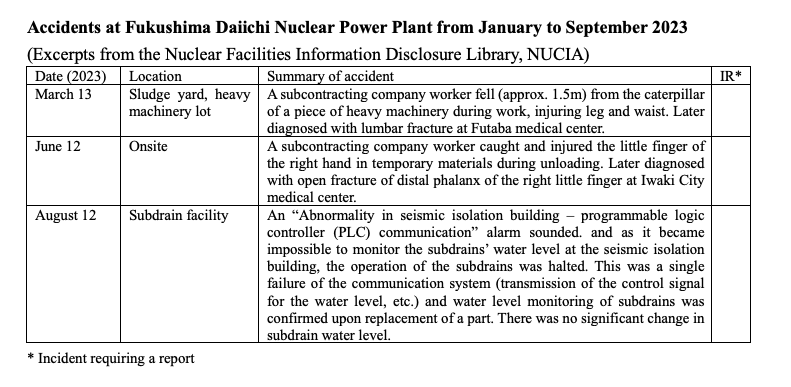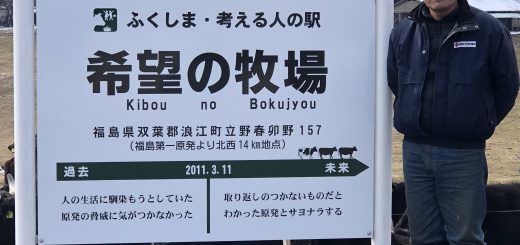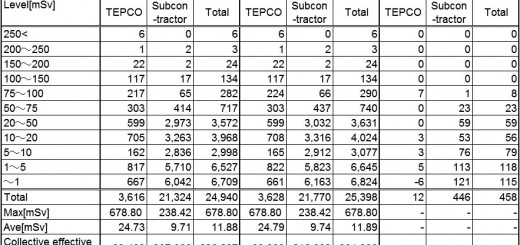Fukushima Now Part 2: Current State of Post-Accident Operations at Fukushima Daiichi Nuclear Power Station (Jan. to Sep. 2023)
By Matsukubo Hajime (CNIC)
State of the Plant
The water temperature in the containment vessels and the spent fuel pools (SFPs) shows no great variation despite seasonal temperature changes. The state of releases of Xenon-135 (half-life roughly nine hours), released when uranium fuel undergoes fission, is also unchanged and it can therefore be estimated that the state of the reactors is stable. Further, around 10,000 becquerels per hour (Bq/h) of radioactive materials were being released to the atmosphere from the buildings (TEPCO assessment in September 2023, Fig.1).
Fig. 1. Radioactivity from Units 1 to 4 of Fukushima Daiichi Nuclear Power Station (Bq/h) released to the air
At the same time, decay heat has fallen greatly with the passage of time, and thus the volume of cooling water injected into the reactors has been reduced (falling from 7-10m3 per hour in May 2011 to 1.3-2.5m3 per hour as of September 2022).
The state of removal of spent nuclear fuel from the SFPs is summarized in Table 1. Spent nuclear fuel removal from Units 3 and 4 has been completed. Preparations are now being made to remove the spent nuclear fuel from Units 1 and 2.
The removal of fuel debris has been delayed. Experimental removal using a removal device (a folding robot arm of 22m in length) originally scheduled in the Mid-term Roadmap to take place in Unit 2 in FY2021 (now scheduled for some time in FY2023), firstly experienced problems in opening the reactor vessel penetration hatch (X-6 penetration) to be used. Beginning in April, the work was scheduled to be completed in about a month but was finally completed in October. Inside the penetration, cables, etc. which melted during the accident have fused and are lying in a heap, making it impossible to insert the device. TEPCO plans to push the accumulated materials into the reactor vessel using water and machinery, but the prospects appear bleak. In addition, investigations are ongoing due to water level reductions occurring in the Unit 1 pressure containment vessel (PCV) and Unit 3 PCV and suppression chamber.
There has been progress in the removal of piping for the standby gas treatment system (SGTS, the piping that connects the reactor building with the Units 1 and 2 exhaust stack, and which was contaminated inside during venting). Since it interfered with installation work for the large-scale cover on the Unit 1 building, removal work on the SGTS piping had begun in March 2022. That was supposed to be completed in about a month but ran into frequent problems and was temporarily halted. Work was resumed on April 18, 2023, but again ran into a number of problems. The work was due to be completed in May, but the removal work was finally completed on July 14.
Changes in the average number of workers onsite per day is shown in Fig.2. As of September 2023, the number of workers was 4,590.
Fig. 2. Change in average number of workers (actual values) per day on weekdays
State of Contaminated Water
Contaminated water countermeasures at Fukushima Daiichi Nuclear Power Station (FDNPS) can be broadly divided into three areas: 1) Reduction of groundwater flowing into buildings, 2) Reduction of contaminated water flowing into the sea, and 3) Reduction of the toxicity of contaminated water. The main countermeasures to reduce water inflow into the buildings are, from higher elevations downward, (A) Pumping up groundwater at the groundwater bypass and releasing it into the sea (861,862m3 up to November 16, 2023), B) Installation of a frozen earth barrier (on-land water barrier, total length roughly 1,500m) surrounding FDNPS Units 1-4. C) Pumping up water at the subdrains and releasing it into the sea (1,606,834m3 up to November 15), and D) Paving of the site with asphalt to suppress permeation of rainwater into the soil. Measures to prevent the discharge of contaminated water into the ocean include A) Groundwater leakage prevention by a steel water barrier on the sea-side, B) Pumping up of groundwater dammed up behind the sea-side water barrier from the well points and groundwater drains. Due to these measures, the volume of contaminated water that was 490m3/day in FY2015 fell to 90m3/day in FY2022, partly due to the fact that there were no intensive rainstorms during that year.
In the reduction of the toxicity of contaminated water, cesium and strontium are removed, and after the removal of impurities using a reverse osmosis (RO) membrane, 62 radionuclides are then removed by the multi-radionuclide removal equipment (ALPS – Advanced Liquid Processing System). The water is then stored in tanks (containing 1,328,208m3 as of November 9, 2023. However, due to past equipment malfunctions and operational policies, around 65% of the stored water exceeds the notification concentration). Oceanic release of the ALPS-treated contaminated water began on August 24, 2023, a total of 15,598m3 being released in two batches by October. Further, roughly 12,240m3 of water remain in buildings, as well as 7,962m3 strontium-treated water, etc., 5,162m3 water treated by RO, and 9,371m3 concentrated wastewater, etc. also exist onsite.







